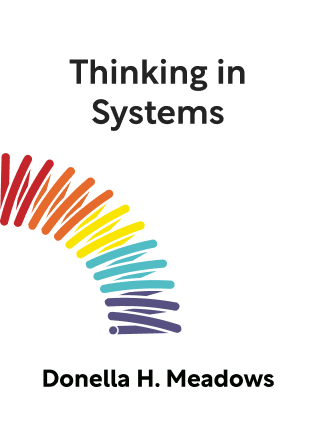

This article is an excerpt from the Shortform summary of "Thinking in Systems" by Donella H. Meadows. Shortform has the world's best summaries of books you should be reading.
Like this article? Sign up for a free trial here .
What are Donella Meadows’ leverage points? How can these leverage points help you develop top-knotch systems in the systems thinking model?
Donella Meadows’ leverage points in a system are places where you can intervene in a system. Leverage points are important for when you have to change your system.
Read more about Donella Meadows’ leverage points in systems thinking and how they work.
Donella Meadows’ Leverage Points
Donella Meadows’ Leverage points in a system are places to intervene in a system. It’s important to 1) find the right leverage point, and 2) push it in the right direction.
Counter-intuitively, people often find a good leverage point, but push it in the wrong direction. Remember the car lot, where reducing delays actually worsened the oscillations.
The author presents 12 leverage points in order of increasing effectiveness.
These twelve leverage points are just a guideline. The exact order is less important than which leverage points are more or less changeable in the system you’re studying.
Understanding leverage points in theory is just the beginning. Now you need to deeply analyze a system—understand its structure, its rules, its paradigms—to begin to know where you can push and prod. To get an accurate understanding, you may need to discard your own prior assumptions and paradigms about how the world works.
12: Parameters
First on the list of the 12 leverage points is parameters. Parameters are numbers described in the system. These include the level of the stock, the quantity of the flows, and more generally it includes swapping individual elements in the same system.
We spend the vast majority of our time worrying about parameters, but the author argues this is definitively the least effective place to intervene. For example:
- When concerned about the national debt, politicians spend much of their time negotiating incremental changes to budgets and tax rates. Yet the national debt continues growing, regardless of who’s in power.
- The Federal Reserve tinkers with interest rates, but this hasn’t ever stopped economic cycles from happening.
11: Stocks
We’ve learned that stocks are buffers that can stabilize the system over fluctuating flow rates. Your bank account is a stock of money that helps you withstand volatility in your income and expenses.
Changing the stock changes the behavior of the system. You can stabilize a system by increasing the stock, but this comes at the cost of efficiency—larger stocks cost more to build or maintain. In contrast, you can increase efficiency by decreasing the stock, but this comes at the cost of lower robustness.
- For example, just-in-time manufacturing decreases the size of the inventory while relying on more frequent deliveries. This makes it more agile to shifting customer demand, but makes it more vulnerable to supply disruptions.
10: Stock-and-Flow Structure
Changing the stock-and-flow structure means changing which flows are connected to which stocks. This can change the behavior of the system:
- In constructing new highways, roads, and parking lots, urban planners reconfigure how traffic flows the stock-and-flow structure.
- (Shortform example: A government could change how money flows—currently it receives taxation from citizens and allocates budget to departments, which then returns to citizens. Changing the structure of this could lead to different system behaviors.)
9: Delays
As we’ve seen, delays in feedback loops tend to cause oscillations. In turn, oscillations worsen the effectiveness of your decisions, because you’re making decisions with delayed information. Furthermore, the results of your actions are delayed—by the time your actions have results, the situation may have changed so that your actions have become inappropriate.
Changing the length of delays affects system behavior:
- Delays that are too short cause overreaction, leading to higher-frequency oscillations.
- Delays set just right can dampen oscillations and introduce stability.
- Delays that are too long can lead to exploding oscillations, or push a system past a breaking point beyond which it cannot return (such as overfishing to extinction).
8: Balancing Feedback Loops
A balancing feedback loop keeps a stock at a setpoint. It can be broken down into components and parameters:
- The speed and accuracy of monitoring
- The speed and intensity of the response
- The flows by which the response achieves its goal
Each of Donella Meadows’ twelve leverage points in a system can be used for changing how the balancing feedback loop works.
The balancing feedback loop should be designed to be strong enough to regulate whatever it’s regulating. If the feedback loop is too weak for the system changes, it will fail to keep the stock at its desired setpoint.
7: Reinforcing Feedback Loops
Reinforcing feedback loops grow exponentially; left unchecked, they can cause serious, irreversible damage.
The leverage point for reinforcing feedback loops is its gain, or its growth rate.
Often, reinforcing feedback loops are countered by balancing feedback loops. An intuitive response to controlling a reinforcing feedback loop is to strengthen the balancing feedback loop. But it’s often easier to simply reduce the growth rate of the reinforcing feedback loop, to keep it more manageable.
6: Information Flow
In a system, decisions and well-functioning feedback loops often require information. The car lot manager requires information about current inventory; a democracy requires information about the government for voters.
In contrast, missing information can lead to system malfunction. People without information cannot make decisions to meet the system goals. The leverage point is then to provide the right information in the right form.
5: System Rules
A system’s rules define its boundaries. These include national constitutions, laws, incentives, punishments, and contracts.
In a well-functioning system, good rules are set that achieve the system’s goals. (Recall from the last chapter that bad rules invite counterproductive evasion or cause actors to chase the wrong goal.)
Changing the rules can dramatically change behavior.
- Imagine a university where the teachers paid the students to attend class.
- Imagine a nation that suppressed the constitutional right to free speech.
4: Self-Organization
Self-organization is the ability of a system to change itself, and possibly reinvent itself. This leads to impressive resilience, as the system can adapt to changing circumstances. It’s also more powerful than any leverage point we’ve discussed so far, because a self-organizing system can improve its rules, information flow, and feedback loops.
As previously explained, vastly complex self-organization can result from a few simple rules:
- Biological evolution results from 1) the encoding of life in DNA, 2) the ability to generate mutations in DNA, and 3) the pressure of natural selection to select for the more successful mutations.
- Likewise, human technology develops with 1) the knowledge of existing science and technology, 2) the human creativity that generates new innovations, and 3) the market forces that select for more useful innovations and reward creators.
The leverage point is therefore to modify a system’s ability to self-organize. On one hand, you can improve a system’s resilience by enabling self-organization.
3: System Goals
A system’s goals determine its behaviors. Changing goals can mutate every lower leverage point to suit the system’s new goals.
Usually changing elements in a system has little effect, except if the element can change higher leverage points, such as system goals. Donella Meadows’ leverage points in systems thinking gives these examples:
- Put Hitler in charge of 1930s Germany, and you create a Nazi Germany with Nazi goals and very different system behaviors.
- Put Gorbachev in charge of the Soviet Union, and you create goals of glasnost and perestroika, in turn changing the society’s information flows and ability to self-organize.
Therefore, the author argues that any technology or system isn’t inherently good or bad. It depends on the goals of who’s using it.
2: System Paradigm
A system’s paradigms are its implicit beliefs about how the world works. They’re often so deeply ingrained in our minds that we don’t consciously articulate them—there’s no need to, because we believe everyone else believes them too.
In Western societies, we have these paradigms:
- Money represents value. Someone who has more money is more valuable than someone who has less of it.
- It’s possible for someone to “own” land on this planet.
- Growth is good. Continuous improvement is good, and stasis is bad.
These paradigms are so natural we don’t often think about them, yet they govern much of what we do. These paradigms drive every lower leverage point—the system goals, the information flows, and so on. These paradigms govern how we set up rules around property ownership, how we set up systems for social welfare, and how we reward system actors that produce growth. Donella Meadows’ leverage points in systems thinking points out that these leverage points are sometimes obvious, and other times difficult to find.
1: Transcending Paradigms
The highest leverage point, even beyond system paradigms, is to free yourself from fixed paradigms. A paradigm is just an idea. No paradigm is absolute truth, and it contains just a small slice of understanding an endlessly complex universe. To transcend paradigms is to prevent yourself from being fixed to any particular paradigm, and to be flexible.
(Ironically, the idea that there is no true paradigm is itself a paradigm, and the author finds this hilarious.)
To let go of paradigms is to be comfortable with not knowing, not having certainty. This is empowering—if you are no longer enslaved by paradigms, then you can choose whichever one you please, or none at all.
The twelve leverage points in systems thinking can help you identify where and when you can intervene in a system.

———End of Preview———
Like what you just read? Read the rest of the world's best summary of Donella H. Meadows's "Thinking in Systems" at Shortform .
Here's what you'll find in our full Thinking in Systems summary :
- How the world, from bathtub faucets to fish populations, can be seen as simple systems
- The key system traps that hold back progress, such as escalating arms races and policy addiction
- Why seeing the world as systems can give you superpowers in work and life






